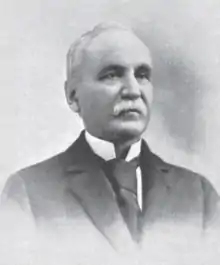Franklin Joseph Dickman | |
|---|---|
 | |
| Justice of the Ohio Supreme Court | |
| In office November 11, 1886 – February 9, 1895 | |
| Appointed by | Joseph B. Foraker |
| Preceded by | William Wartenbee Johnson |
| Succeeded by | John Allen Shauck |
| Member of the Ohio House of Representatives from the Cuyahoga County district | |
| In office January 6, 1862 – January 3, 1864 Serving with Charles H. Babcock Seneca O. Griswold | |
| Preceded by | Richard C. Parsons C. T. Blakeslee |
| Succeeded by | Charles H. Babcock Azariah H. Everett Charles B. Lockwood |
| Personal details | |
| Born | August 28, 1828 Petersburg, Virginia |
| Died | February 12, 1908 (aged 79) Cleveland, Ohio |
| Resting place | Lake View Cemetery |
| Political party | Republican, Democratic |
| Spouse | Anna Eliza Neil |
| Children | four |
| Alma mater | Brown University |
Franklin J. Dickman (August 28, 1828 – February 12, 1908) was a Republican politician in the U.S. State of Ohio who was in the Ohio House of Representatives and was an Ohio Supreme Court Judge 1886–1895.
Franklin Dickman was a native of Petersburg, Virginia, born August 28, 1828.[1] At age sixteen he entered Brown University in Providence, Rhode Island, from which he graduated. Studied law under Charles S. Bradley, and opened an office in Providence.[2] He was a candidate for Rhode Island Attorney General as a Democrat in 1857, but lost in the General Election. In 1858, appointed a member of the Board of Visitors of the United States Military Academy, and selected secretary. He authored the widely circulated report of the board.[2] In 1858, he moved to Cleveland, Ohio, and became a Republican during the American Civil War.[3]
In 1861, Dickman represented Cuyahoga County in the Ohio House of Representatives in the 55th General Assembly, (1862–1863),[4] as a Democrat.[5] Married Anna Eliza Neil of Columbus December 24, 1862,[1] who had four children.[5] At the end of his term he formed a partnership with Rufus P. Spalding, which continued until 1875.[1]
In 1867, President Johnson appointed Dickman as United States District Attorney for the Northern district of Ohio, and he resigned in 1869.[5][6] In 1883 he was appointed on the Supreme Court Commission of Ohio for two years.[3] In 1886, Governor Foraker appointed him to a vacancy on the Ohio Supreme Court.[3] In 1887, he defeated Democrat Virgil P. Kline for the remainder of the term,[7] and he won a full five-year term in 1889 over Democrat Martin Dewey Follett.[8] At the 1894 State Republican Convention, Dickman lost out to John Allen Shauck for the nomination.[9] He died February 12, 1908, at Cleveland.[10] He is buried in Lake View Cemetery[5]
Notes
- 1 2 3 Reed, p. 146.
- 1 2 Cleave, p. 72.
- 1 2 3 Smith, p. 545.
- ↑ Ohio 1917, p. 282.
- 1 2 3 4 "Franklin Joseph Dickman". The Supreme Court of Ohio & The Ohio Judicial System. Retrieved 2012-01-19.
- ↑ "U.S. Attorney, Northern District of Ohio". Sixth Circuit. Archived from the original on 2009-05-13. Retrieved 2012-01-19.
- ↑ Smith, p. 541.
- ↑ Smith, p. 579.
- ↑ Smith, p. 653.
- ↑ "Franklin Dickman Dead" (PDF). New York Times. February 13, 1908. Retrieved 2012-01-19.
References
- Smith, Joseph P, ed. (1898). History of the Republican Party in Ohio. Vol. I. Chicago: the Lewis Publishing Company.
- Ohio General Assembly (1917). Manual of legislative practice in the General Assembly. State of Ohio.
- Reed, George Irving; Randall, Emilius Oviatt; Greve, Charles Theodore, eds. (1897). Bench and Bar of Ohio: a Compendium of History and Biography. Vol. 2. Chicago: Century Publishing and Engraving Company.
- Cleave, Egbert (1875). City of Cleveland and Cuyahoga County: taken from Cleave's Biographical Cyclopaedie of the state of Ohio. Cleveland: Fairbanks, Benedict & Co.
- Franklin J. Dickman at Find a Grave